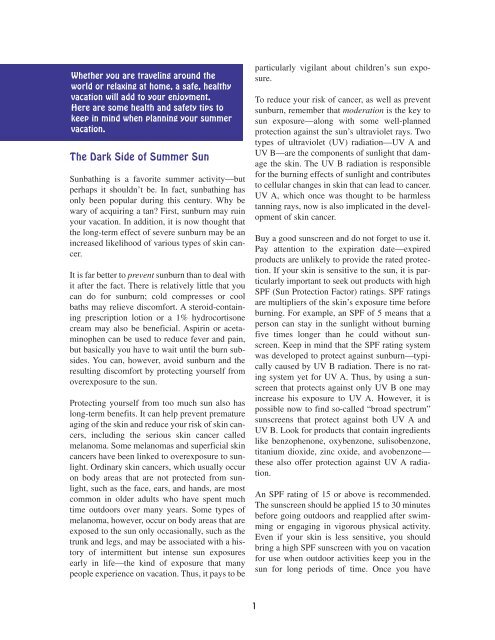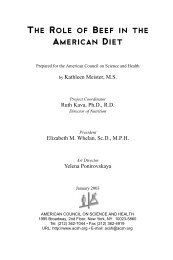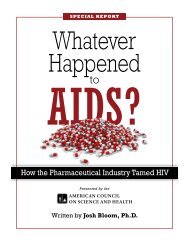View pdf - American Council on Science and Health
View pdf - American Council on Science and Health
View pdf - American Council on Science and Health
Create successful ePaper yourself
Turn your PDF publications into a flip-book with our unique Google optimized e-Paper software.
Whether you are traveling around the<br />
world or relaxing at home, a safe, healthy<br />
vacati<strong>on</strong> will add to your enjoyment.<br />
Here are some health <strong>and</strong> safety tips to<br />
keep in mind when planning your summer<br />
vacati<strong>on</strong>.<br />
The Dark Side of Summer Sun<br />
Sunbathing is a favorite summer activity—but<br />
perhaps it shouldn’t be. In fact, sunbathing has<br />
<strong>on</strong>ly been popular during this century. Why be<br />
wary of acquiring a tan? First, sunburn may ruin<br />
your vacati<strong>on</strong>. In additi<strong>on</strong>, it is now thought that<br />
the l<strong>on</strong>g-term effect of severe sunburn may be an<br />
increased likelihood of various types of skin cancer.<br />
It is far better to prevent sunburn than to deal with<br />
it after the fact. There is relatively little that you<br />
can do for sunburn; cold compresses or cool<br />
baths may relieve discomfort. A steroid-c<strong>on</strong>taining<br />
prescripti<strong>on</strong> loti<strong>on</strong> or a 1% hydrocortis<strong>on</strong>e<br />
cream may also be beneficial. Aspirin or acetaminophen<br />
can be used to reduce fever <strong>and</strong> pain,<br />
but basically you have to wait until the burn subsides.<br />
You can, however, avoid sunburn <strong>and</strong> the<br />
resulting discomfort by protecting yourself from<br />
overexposure to the sun.<br />
Protecting yourself from too much sun also has<br />
l<strong>on</strong>g-term benefits. It can help prevent premature<br />
aging of the skin <strong>and</strong> reduce your risk of skin cancers,<br />
including the serious skin cancer called<br />
melanoma. Some melanomas <strong>and</strong> superficial skin<br />
cancers have been linked to overexposure to sunlight.<br />
Ordinary skin cancers, which usually occur<br />
<strong>on</strong> body areas that are not protected from sunlight,<br />
such as the face, ears, <strong>and</strong> h<strong>and</strong>s, are most<br />
comm<strong>on</strong> in older adults who have spent much<br />
time outdoors over many years. Some types of<br />
melanoma, however, occur <strong>on</strong> body areas that are<br />
exposed to the sun <strong>on</strong>ly occasi<strong>on</strong>ally, such as the<br />
trunk <strong>and</strong> legs, <strong>and</strong> may be associated with a history<br />
of intermittent but intense sun exposures<br />
early in life—the kind of exposure that many<br />
people experience <strong>on</strong> vacati<strong>on</strong>. Thus, it pays to be<br />
particularly vigilant about children’s sun exposure.<br />
To reduce your risk of cancer, as well as prevent<br />
sunburn, remember that moderati<strong>on</strong> is the key to<br />
sun exposure—al<strong>on</strong>g with some well-planned<br />
protecti<strong>on</strong> against the sun’s ultraviolet rays. Two<br />
types of ultraviolet (UV) radiati<strong>on</strong>—UV A <strong>and</strong><br />
UV B—are the comp<strong>on</strong>ents of sunlight that damage<br />
the skin. The UV B radiati<strong>on</strong> is resp<strong>on</strong>sible<br />
for the burning effects of sunlight <strong>and</strong> c<strong>on</strong>tributes<br />
to cellular changes in skin that can lead to cancer.<br />
UV A, which <strong>on</strong>ce was thought to be harmless<br />
tanning rays, now is also implicated in the development<br />
of skin cancer.<br />
Buy a good sunscreen <strong>and</strong> do not forget to use it.<br />
Pay attenti<strong>on</strong> to the expirati<strong>on</strong> date—expired<br />
products are unlikely to provide the rated protecti<strong>on</strong>.<br />
If your skin is sensitive to the sun, it is particularly<br />
important to seek out products with high<br />
SPF (Sun Protecti<strong>on</strong> Factor) ratings. SPF ratings<br />
are multipliers of the skin’s exposure time before<br />
burning. For example, an SPF of 5 means that a<br />
pers<strong>on</strong> can stay in the sunlight without burning<br />
five times l<strong>on</strong>ger than he could without sunscreen.<br />
Keep in mind that the SPF rating system<br />
was developed to protect against sunburn—typically<br />
caused by UV B radiati<strong>on</strong>. There is no rating<br />
system yet for UV A. Thus, by using a sunscreen<br />
that protects against <strong>on</strong>ly UV B <strong>on</strong>e may<br />
increase his exposure to UV A. However, it is<br />
possible now to find so-called “broad spectrum”<br />
sunscreens that protect against both UV A <strong>and</strong><br />
UV B. Look for products that c<strong>on</strong>tain ingredients<br />
like benzophen<strong>on</strong>e, oxybenz<strong>on</strong>e, sulisobenz<strong>on</strong>e,<br />
titanium dioxide, zinc oxide, <strong>and</strong> avobenz<strong>on</strong>e—<br />
these also offer protecti<strong>on</strong> against UV A radiati<strong>on</strong>.<br />
An SPF rating of 15 or above is recommended.<br />
The sunscreen should be applied 15 to 30 minutes<br />
before going outdoors <strong>and</strong> reapplied after swimming<br />
or engaging in vigorous physical activity.<br />
Even if your skin is less sensitive, you should<br />
bring a high SPF sunscreen with you <strong>on</strong> vacati<strong>on</strong><br />
for use when outdoor activities keep you in the<br />
sun for l<strong>on</strong>g periods of time. Once you have<br />
1










